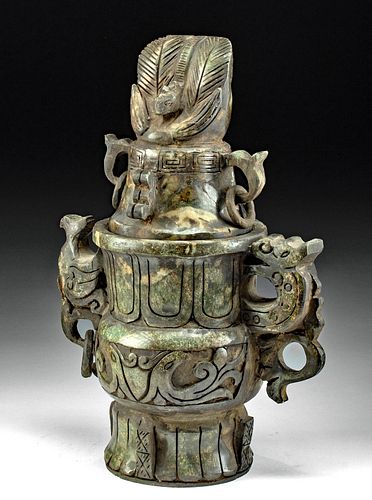19th C. Chinese Qing Nephrite Jade Lidded Jar
Lot 123
About Seller
Artemis Fine Arts
686 S Taylor Ave, Ste 106
Louisville, CO 80027
United States
Selling antiquities, ancient and ethnographic art online since 1993, Artemis Gallery specializes in Classical Antiquities (Egyptian, Greek, Roman, Near Eastern), Asian, Pre-Columbian, African / Tribal / Oceanographic art. Our extensive inventory includes pottery, stone, metal, wood, glass and textil...Read more
Categories
Estimate:
$2,600 - $3,900
Absentee vs Live bid
Two ways to bid:
- Leave a max absentee bid and the platform will bid on your behalf up to your maximum bid during the live auction.
- Bid live during the auction and your bids will be submitted real-time to the auctioneer.
Bid Increments
| Price | Bid Increment |
|---|---|
| $0 | $25 |
| $300 | $50 |
| $1,000 | $100 |
| $2,000 | $250 |
| $5,000 | $500 |
| $10,000 | $1,000 |
| $20,000 | $2,500 |
| $50,000 | $5,000 |
| $100,000 | $10,000 |
| $200,000 | $20,000 |
About Auction
By Artemis Fine Arts
Jul 22, 2021
Set Reminder
2021-07-22 10:00:00
2021-07-22 10:00:00
America/New_York
Bidsquare
Bidsquare : Summer Antiquities & Ethnographic Art Auction
https://www.bidsquare.com/auctions/artemis-gallery/summer-antiquities-ethnographic-art-auction-7245
Travel around the world and back in time...and be amazed at the treasures you will find! Antiquities from Egypt, Greece, Italy and the Near East, Asian, Pre-Columbian, African / Tribal / Oceanic, Native American, Spanish Colonial, Russian Icons, Fossils, Fine Art, much more! Artemis Fine Arts info@artemisgallery.com
Travel around the world and back in time...and be amazed at the treasures you will find! Antiquities from Egypt, Greece, Italy and the Near East, Asian, Pre-Columbian, African / Tribal / Oceanic, Native American, Spanish Colonial, Russian Icons, Fossils, Fine Art, much more! Artemis Fine Arts info@artemisgallery.com
- Lot Description
East Asia, China, late Qing Dynasty to early Republic Period, ca. 19th to early 20th century CE. A marvelous, lidded vessel skillfully carved from a beautiful jade of sage, midnight green, mocha, and cream hues. Sitting upon a gently flared, pedestal foot, the elegant jar presents a cylindrical form with a pair of zoomorphic handles in the forms of a bird and a serpent, a bulging bottom section, a lipped rim, and an intricate, convex lid topped by the figure of a seated bird, likely a phoenix. The body of the vessel is intricately adorned with an incised geometric motif, while the bulbous section above the foot is embellished by a swirling phytomorphic relief. A pair of loops sit below the handles, one of which holding a sculpted jade ring and 2 similar loops, though these are in the form of fish or dolphins, flank the lid, both also bearing a jade ring. Incised details embellish all of the zoomorphic imagery as well as decorate the lid with a spiraling pattern. While some decorative works declined during the Qing Dynasty, jade carving attained a sophisticated level of technique as exemplified by this piece. Size: 8.5" in diameter x 12.75" H (21.6 cm x 32.4 cm)
The phoenix is one of the most important symbols in Chinese art and literature, and images of the phoenix have appeared on Chinese jade and pottery pieces for more than 8000 years, with the first examples from the Hongshan Neolithic period. According to legend, the phoenix is the most beautiful of all birds, called the feng huang (also fenghuang) and the etymology of the name is derived from "emperor". The phoenix only appears during times of prosperity and peace, second only to the dragon in the Chinese pantheon of supernatural creatures. The Feng Huang also symbolizes the harmonious union of yin and yang. In both ancient and modern Chinese visual culture, phoenixes (in addition to dragons) are found in the iconographic programs of decorations and gifts for weddings and royalty. The reason for this is that the Chinese traditionally regard the dragon and the phoenix as symbolic of happy relationships between husband and wife.
Provenance: ex-Ashland University Museum, Ashland, Ohio, USA
All items legal to buy/sell under U.S. Statute covering cultural patrimony Code 2600, CHAPTER 14, and are guaranteed to be as described or your money back.
A Certificate of Authenticity will accompany all winning bids.
PLEASE NOTE: Due to recent increases of shipments being seized by Australian & German customs (even for items with pre-UNESCO provenance), we will no longer ship most antiquities and ancient Chinese art to Australia & Germany. For categories of items that are acceptable to ship to Australia, please contact us directly or work with your local customs brokerage firm.
#164863One loop on lid repaired with break lines visible. Some nicks, chips, and abrasions to areas. Otherwise, very nice with lovely patina and earthen deposits throughout.Condition
- Shipping Info
-
All shipping is handled in-house for your convenience. Your invoice from Artemis Gallery will include shipping calculation instructions. If in doubt, please inquire BEFORE bidding for estimated shipping costs for individual items.
-
- Buyer's Premium



 EUR
EUR CAD
CAD AUD
AUD GBP
GBP MXN
MXN HKD
HKD CNY
CNY MYR
MYR SEK
SEK SGD
SGD CHF
CHF THB
THB














